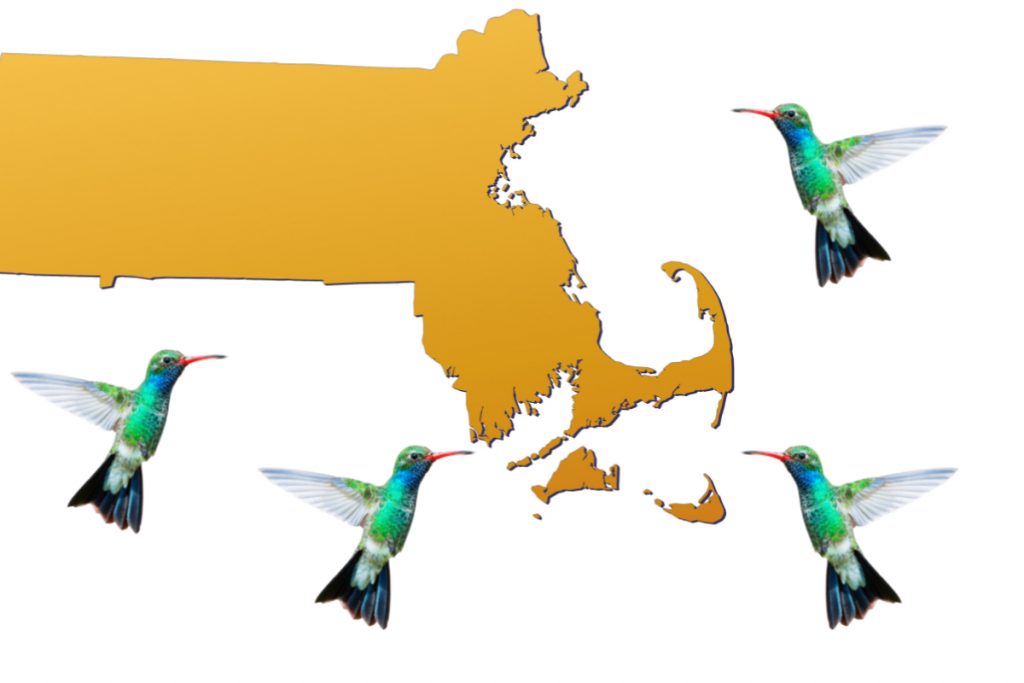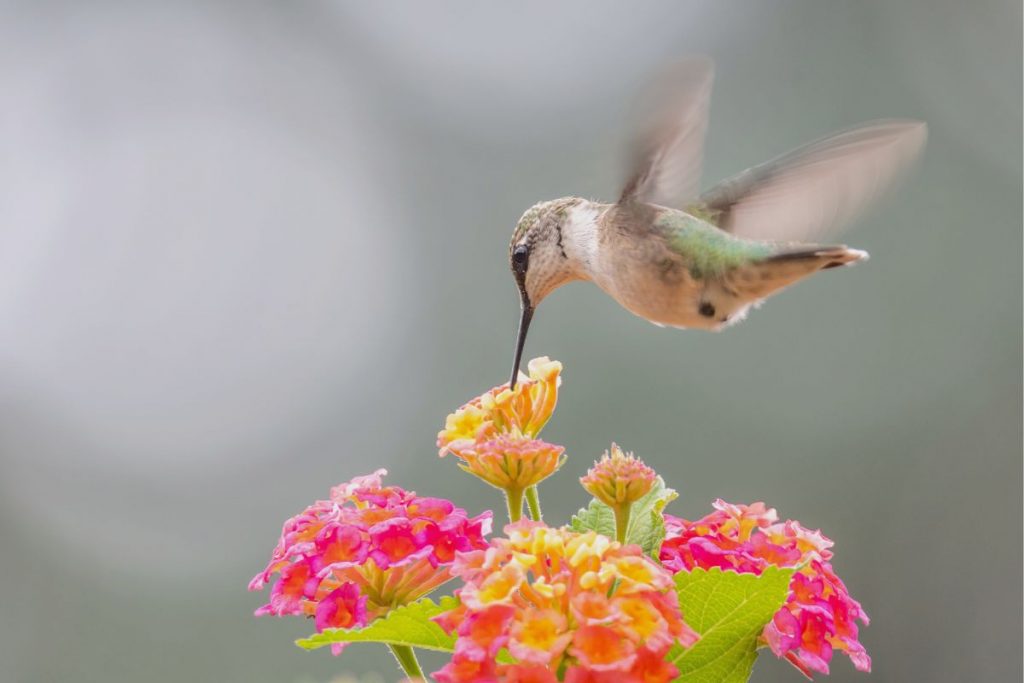If you’re wondering whether hummingbirds can be found in Massachusetts, then I have good news for you because the answer is yes! Ruby-throated Hummingbirds, which are native to the state, can be spotted in Massachusetts.
In this article, I’ll give you all the information you need about hummingbirds in Massachusetts. Learn about their behaviours, find the best places to see them, attract them to your yard, and enjoy their wonders in your garden. Let’s dive in!
Do Hummingbirds Live in Massachusetts?
Yes, Massachusetts is home to the Ruby-throated Hummingbird. This is the only breeding hummingbird species found in the state. They are typically present from late April through early October.
You can easily recognize these bright birds by their shiny green upperparts and red throats. You can often see them near flowers or feeders, showing off their amazing flying skills.

Local residents take delight in setting up feeders to attract and observe these mesmerising birds in their gardens. Their rapid wing beats and darting movements are truly a sight to behold.
Related post to read about Best Hummingbird Feeders.
- Do Hummingbirds Live in Massachusetts?
- A Closer Look at the Ruby-throated Hummingbird
- Where to Spot Hummingbirds in Massachusetts – Best Locations
- Attracting Hummingbirds to Your Massachusetts Garden
- The Importance of Citizen Science and Conservation
- When Do Hummingbirds Arrive in Massachusetts Each Year?
- When Do Hummingbirds Leave Massachusetts Each Year?
- Conclusion
- Frequently Asked Questions (FAQs)
- Q: How many species of hummingbirds can be found in the United States?
- Q: What is the most common hummingbird seen in the eastern United States?
- Q: What type of flowers do hummingbirds prefer when feeding on nectar?
- Q: When do hummingbirds typically arrive in Massachusetts each year?
- Q: How can I attract hummingbirds to my yard in Massachusetts?
- Q: What is the proper ratio for making homemade nectar?
- Q: How often should hummingbird feeders be cleaned?
- Q: Why are hummingbirds very territorial, especially in summer?
- Q: How much do hummingbirds eat relative to their tiny size?
- Q: How can I provide shelter for hummingbirds in my yard?
- Q: How do I know when hummingbirds have returned to my area each year?
- Q: What are key signs I can use to identify a male Ruby-throated Hummingbird?
- Q: Do hummingbird species migrating through Massachusetts interbreed?
- Q: What is an interesting fact about hummingbird migration?
- Q: How has climate change impacted hummingbird migration patterns?
- Q: Why are hummingbirds important for pollination?
- Q: How can I help hummingbird conservation efforts?
- Q: What is the best way to clean a hummingbird feeder?
- Image Gallery – Are There Hummingbirds In Massachusetts?

A Closer Look at the Ruby-throated Hummingbird
Physical Characteristics
The Ruby-throated Hummingbird is a small bird. It is about 7-9 centimetres long and weighs 2-6 grams.
Males have a striking iridescent red throat, while females have a white throat and greyish-green upper parts. Both sexes have a metallic green back and a slender, needle-like bill, perfect for sipping nectar from flowers.
Behaviour and Feeding Habits
These agile birds have a rapid, darting flight and can hover as they feed on nectar. During the breeding season, they also consume insects and spiders for extra protein.
Ruby-throated Hummingbirds are territorial. They often chase other birds away from their feeding spots.
Migration and Breeding
Ruby-throated Hummingbirds usually come to Massachusetts in late April or early May. They make an impressive journey across the Gulf of Mexico.
They breed throughout the state and raise their young in tiny, cup-shaped nests built from plant materials and spider silk.
When the weather gets colder in September or October, these birds fly south to Central America for the winter.

Where to Spot Hummingbirds in Massachusetts – Best Locations
There are tons of great spots around Massachusetts where you can catch a glimpse of these whirring-winged wonders. Some top sites include the Boston Public Garden, Gloucester’s Stage Fort Park, Wachusett Meadow Wildlife Sanctuary, and the Quabbin Reservoir.
Other can’t-miss locations for possible sightings include Crane Beach in Ipswich and Cape Ann in Rockport. Wherever your travels take you around the state, keep an eye out for flitting flashes of iridescent green and red.
Attracting Hummingbirds to Your Massachusetts Garden
Want to bring those zooming beautiful birds to your own backyard? Start by planting some ruby-throated favourites like bee balm, trumpet vine, and cardinal flowers. Make sure to include flowers across seasons for nonstop nectar.
Next, get a feeder or two and fill them with a 4-to-1 sugar-water solution. Change it out regularly to avoid mold. Give them a safe space to rest by planting thickets and trees. Before you know it, your gardens will be buzzing with hummingbirds!
Also, to protect the health of hummingbirds and other wildlife, avoid using pesticides in your garden. These chemicals can contaminate the birds’ food sources and harm the insects they rely on for protein. Instead, consider implementing organic gardening practices.
The Importance of Citizen Science and Conservation
To make sure Massachusetts’ tiniest talents stick around, we all need to pitch in. You can contribute to citizen science projects like Journey North by reporting hummingbird sightings, which helps researchers track migration patterns and population trends.
When possible, choose native plants for your garden to provide the best habitat.
Volunteer or donate to groups like Mass Audubon that protect land and educate people about preservation. With some teamwork, we can keep the magic of hummingbirds alive!
When Do Hummingbirds Arrive in Massachusetts Each Year?
As noted above, the Ruby-throated Hummingbird is the main species found in Massachusetts. These tiny travellers make their way north to the state each spring as the weather warms.
Ruby-throated hummingbirds usually arrive in mid to late April. Sometimes, a few come in early April.
During mid-April through late May, lots of hummers migrate to the state to refuel. The number of hummers increases in mid-May.
So, while early April sightings do occur, mid-April through May is the prime time to observe the annual return of these energetic migrants. Getting feeders and flowers ready as early as late March will welcome these much-anticipated harbingers of spring back to Massachusetts.
When Do Hummingbirds Leave Massachusetts Each Year?
In Massachusetts, the Ruby-throated Hummingbirds start flying south in late summer and early fall. Most hummingbirds depart between late August and mid-September.
However, some hummingbirds in Massachusetts may stay until early October if there are plenty of wildflowers and feeders with food.
It’s common to see significant declines in hummer numbers by late September in most regions of Massachusetts.
By mid-October, only rare stragglers remain in the state. The colder weather and scarce food sources spur the final southbound migrants to embark on their incredible journeys back to Central America and Mexico.
Late August to mid-September is the best time to see hummingbirds in your garden or local parks. You can still spot them in September and early October in warm years. Then, wish them well as they head off to winter homes thousands of miles away!
Conclusion
The Ruby-throated Hummingbird’s speedy stopovers in Massachusetts bring a dose of wonder to the state each year.
Now that you know a bit more about where to spot them, how to attract them, and how to help them thrive, you can play a big part in keeping their spectacular shows going.
Just remember – a little sweetness goes a long way for our tiniest guests – Hummingbirds!
So, now over to you, have you sighted any hummingbirds in your garden lately? I’d love to hear your thoughts! Thanks for reading.
Frequently Asked Questions (FAQs)
Q: How many species of hummingbirds can be found in the United States?
A: There are over 300 species of hummingbirds in the world, but only around 12 to 17 species regularly breed in the United States. Some common ones include Ruby-throated, Rufous, Allen’s, Anna’s, and Broad-tailed Hummingbirds.
Q: What is the most common hummingbird seen in the eastern United States?
A: The Ruby-throated Hummingbird is the most common and widespread hummingbird in the eastern United States. They can be found in many states along the Atlantic Flyway.
Q: What type of flowers do hummingbirds prefer when feeding on nectar?
A: Hummingbirds are attracted to tubular-shaped flowers that provide easy access to nectar, like trumpet vines, cardinal flowers, salvias, and bee balms. They favour red and orange blossoms.
Q: When do hummingbirds typically arrive in Massachusetts each year?
A: Most Ruby-throated Hummingbirds arrive in Massachusetts between mid to late April, with peak migration in May. Some early arrivals show up in early April.
Q: How can I attract hummingbirds to my yard in Massachusetts?
A: Put out nectar feeders, plant native flowers they like, provide shelter/nesting areas and avoid pesticides. Change nectar every few days.
Q: What is the proper ratio for making homemade nectar?
A: Mix 1 part white sugar with 4 parts water and stir until dissolved. Do not use food colouring or honey.
Q: How often should hummingbird feeders be cleaned?
A: Every 2-3 days in hot weather or every 5 days in cooler temps. Change nectar before it spoils to avoid harming hummingbirds.
Q: Why are hummingbirds very territorial, especially in summer?
A: They are defending their key food source – flower patches and feeders. Males will aggressively guard breeding and feeding territories.
Q: How much do hummingbirds eat relative to their tiny size?
A: Hummingbirds eat up to 2-3 times their body weight in nectar each day! Their rapid metabolism requires lots of energy.
Q: How can I provide shelter for hummingbirds in my yard?
A: Plant dense trees/shrubs that offer protection. Or buy a hummingbird shelter accessory to provide cover from weather/predators.
Q: How do I know when hummingbirds have returned to my area each year?
A: Watch for males arriving first to stake out nesting spots, then look for females soon after. More frequent sightings and activity around feeders.
Q: What are key signs I can use to identify a male Ruby-throated Hummingbird?
A: Males have a bright red throat, green back feathers, and generally white undersides. Females lack the red throat.
Q: Do hummingbird species migrating through Massachusetts interbreed?
A: No, species like Ruby-throated and Rufous Hummingbirds may overlap during migration but do not interbreed.
Q: What is an interesting fact about hummingbird migration?
A: Some species migrate remarkably long distances! For example, the Ruby-throated Hummingbird migrates across the Gulf of Mexico each spring.
Q: How has climate change impacted hummingbird migration patterns?
A: Warming trends have caused earlier spring arrivals and later fall departures in many species as food sources change.
Q: Why are hummingbirds important for pollination?
A: As they feed on flower nectar, they carry pollen between blossoms, making them excellent pollinators for many plant species.
Q: How can I help hummingbird conservation efforts?
A: Avoid pesticides, let some weeds bloom, report sightings to projects like Journey North, and support groups like Audubon that protect habitats.
Q: What is the best way to clean a hummingbird feeder?
A: To clean a hummingbird feeder, use a mild soap solution and water to wash the feeder thoroughly. Make sure to rinse all soap residue and allow the feeder to completely air dry before refilling with fresh nectar. This helps ensure the feeder is safe for hummingbirds. Also, using hot water to raise the feeder is recommended to eliminate bacteria.
Image Gallery – Are There Hummingbirds In Massachusetts?




Related Posts to Read:
- Best Hummingbird Feeders.
- Are There Hummingbirds In Alabama?
- Are There Hummingbirds in Europe?
- Are There Hummingbirds in Australia?
- Are There Hummingbirds In The UK?
- Are There Hummingbirds In The Caribbean?
- Are There Hummingbirds In Canada?
- Are There Hummingbirds In Jamaica?
- Are There Hummingbirds In Florida?
References:
- About Hummingbird (Wikipedia).
- About Massachusetts (Wikipedia)
- Greenewalt, C. H. (1960). Hummingbirds. New York: Doubleday. Google Scholar.
